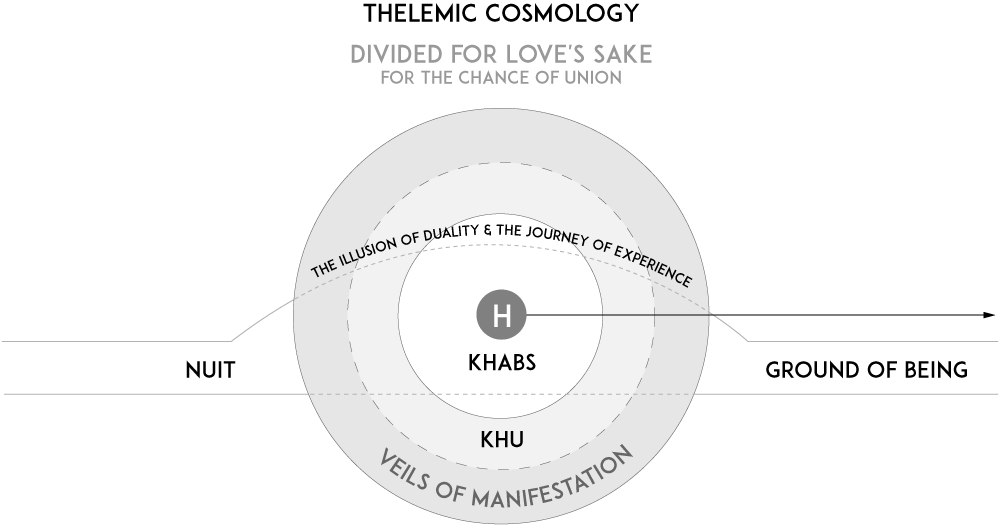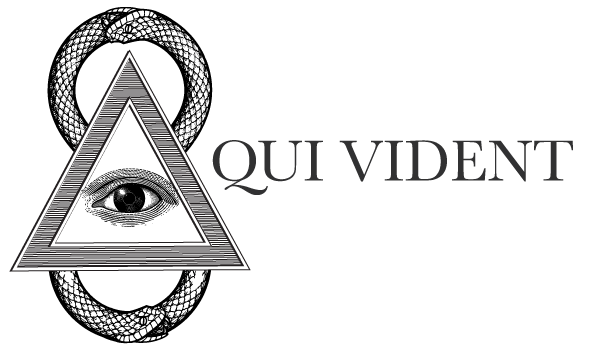Ontology
Ontology is a subset of metaphysics that focuses on the nature of being. It seems to understand the nature of existence and our relationship with it.
[finish introduction]
Thelemic Cosmological Model (TCM)
Crowley was quite clear that a new aeon demanded new models (or “systems of classification“[1]). While the Tree of Life is the predominate form of structure for most Thelemites, even Crowley knew that it was inadequate for the task of representing the perspective of the new aeon. However, he left nothing behind except a slavish adherence to a bastardized Kabbalah/Qabala and its iconography. We can do better.
To this end, a new model is offered here that presents, not a fall from grace or from the face of God or the need to crawl back up “the Tree,“ but as a whole, integral, perfect Star on a journey, with a destiny, and an updated expansion of the Khu and workable explanation for pursuit of the Great Work [“solution of complexes“]. What this model also accomplishes is moving materialism away from a sense of "lower than higher" spiritual perspectives.

Ontological Taxonomy
Nuit as Ground of Being
First, Nuit is indicated as a selection that runs throughout and around the entire circular model. This is to show that Nuit represents the ground of being or that which holds all being and non-being. It cannot be a “thing,” or it would have a causation that comes before it. Nuit is all of existence in posse (in potential) and in esse (in actuality), but she is neither essence nor existence; instead, she undergirds both, i.e., _being-itself.
Basic Axiom:
Existence: “existence asserts the right to exist“ (Liber ABA, p. 579); “Nuit is All that which exists, and *the condition of that existence“ (NC to AL 1.22, emphasis mine)[2]
Consciousness: “the continuity of existence“ [AL 1.26e]
Identity: A is A. (Liber ABA, p. 143fn); “There is none that shall be cast down or lifted up: all is ever as it was.“ [AL 2.58d]
Ontological taxonomy:
Ground of Being: Nu! the hiding of Hadit. [AL 2.1] “Being itself, as present in the ontological awareness, is power of Being but not the most powerful being: it is neither ens realissimum (the most real being) nor ens singularissimum (the most single being). It is the power in everything that has power, be it a universal or an individual, a thing or an experience.“[3]
In Nuit, through the understanding as the ground of being, there can be only and all propositional truths (a priori) but only appropriate [mental] experiential knowledge (a posteriori)—hence, the theology of Hadit arising from Nuit for the purposes of change [development] through experiential consciousness. (cf. NC on AL 1.3, specifically, “Therefore, by the lapse of time, and by virtue of memory, a thing could become something more than itself; thus a real development is possible.“) We, as Stars, are the conduits of a posteriori knowledge [change/development] for Nuit.
Hadit as Ground of Becoming
Second, Hadit (indicated by the ‘H’) is the core of the Star and is each Star’s essential yet impersonal aspect. Hadit is motion-itself, differentiating itself from any other. It is this motion of differentiation that creates the existence of a Star, i.e., the ground of becoming, and that creates the illusion of duality, which allows the journey of experience for each Star.
Ontological taxonomy:
Ground of Becoming: “Had! The manifestation of Nuit.“ [AL 1.1] Therefore, by the lapse of time, and by virtue of memory, a thing could become something more than itself; thus a real development is possible.” (NC on AL 1.3)
Core of Every Star: “Every man and every woman is a star.“ [AL 1.3] “I am the flame that burns in every heart of man, and in the core of every star. I am Life, and the giver of Life, yet therefore is the knowledge of me the knowledge of death.“ [AL 2.6]
Khabs as Destiny-in-Motion
Third, the Khabs is the direction of the Star, the expression of the True Will, and rightfully considered the individual's Authentic Self[4] The arrow from the center is this symbol of direction. Each Star will inherently move in this general direction even if the True Will is not explicitly known, thereby causing change via gathering experience through the interaction of the Khu with all actual and possible experiences. By coming into harmony with this Will, one can utilize “the inertia of the Universe to assist him” through life.
Basic Axiom:
Interior Construction: “The Khabs is in the Khu, not the Khu in the Khabs.“ [AL 1.8] “We have seen that Ra-Hoor-Khuit is in one sense the Silent Self in a man, a Name of his Khabs, not so impersonal as Hadit, but the first and least untrue formulation of the Ego. We are to reverse this self in us, then, not to suppress it and subordinate it. Nor are we to evade it, but to come to it.“ (NC to AL 3.62)
Ontological taxonomy:
Manifestation of Destiny: “The circumference of Nuit touches Ra-Hoor-Khuit, Kether; but her centre Hadit is forever concealed above Kether.“ (OC to AL 2.4) “Ra-Hoor-Khuit is the Crowned and Conquering Child. This is also a reference to the 'Crowned' and Conquering 'Child' in ourselves, our own personal God.“ (NC to AL 3.22)
Khu as the Veils of Manifestation
Fourth, the Khu is the (a) personality, (b) profile, and (c) presentation of the individual, the veils of manifestation or experience. The Khu is the aspect we explore through the Great Work. It is that through which we dig into our personal archeology of authenticity.
Basic Axiom:
Exterior Construction: “The Khabs is in the Khu, not the Khu in the Khabs.“ [AL 1.8] "The Khu in each of us includes the Cosmos as he knows it." [NC to AL 1.9]
The Ontological Trinity or Structures
- Individual and Universal (resistance and participation / agency and communion)
- Becoming and Being (dynamics and form / potentiality and manifestation (or will or movement) / vitality and intentionality)[5]
- Liberty and Destiny (free will and determinism)
The Book of the Law [through AL 1.2-3] offers [one of three dichotomies as] the structure of communion and agency, the universal and the individual that makes up part of the foundation of a Thelemic ontological understanding.
Without communion (the universal[6]), agency (the individual) has no meaning as individualization requires a relationship that is separate, resistant, from both other individual forms as well as the whole of being. Individualization, however, is only individual through the participation with the whole, or communion itself. One could liken communion and agency to the antiquated adage, ‘as above, so below,’ and intuit the symbiotic relationship of this dichotomy.
A star is an individual identity; it radiates energy, it goes, it is a point of view. Its object is to become the whole by establishing relations with other stars. Each such relation is an Event: it is an act of Love under Will.[7]
To put it another way: experience, as such, can only be obtained through the manifestation of agency; that is, through the movement of the individual form in relation to other individual forms. That sense of relation can only occur within the concept of communion, or participation. An individual is not something that can exist within a vacuum, in isolation.
Or, yet one more perspective to stay with the metaphors, the Star (agency) has an ontological relation to the 'community of heaven' (communion) and only by such relation is a Star capable of both existence and experience.
Being something means having a form. Whatever loses its form loses its being. But every form forms something, and this something Tillich calls “dynamics.“ The concept of dynamics is a very complex one with many connotations. Its complexity is due to the fact that it cannot be thought of as something that is; and yet it cannot be thought of as something that is not. Dynamics is the “me on,“ the potentiality of being, which is nonbeing in contrast to pure nonbeing. This polar element to form appears as the Urgrund of Böhme, the will of Schopenhauer, the "will to power" of Nietzsche, the “unconscious“ of Hartmann and Freud, the elan vital of Bergson. Each of these concepts points symbolically to what cannot be named literally. “If it could be named properly it would be a formed being beside others instead of an ontological element in contrast with the element of pure form.“[8]
Attribution
No part of this publication may be used or redistributed for any purpose without the express prior written consent of the author.
Canons of Thelemic Philosophy & Religion © 1996-2024 by Qui Vident.

Comments
If you wish to comment about the materials here, feedback is welcome. Feel free to email questions, comments, and concerns regarding the Canons to curate@quivident.co.
Crowley, A., & Harris, F (2017). The book of Thoth: A short essay on the tarot of the Egyptians, being the Equinox, Volume III, No. 5. Newburyport, MA: Weiser Books. ↩︎
OC or NC=Old or New Comment from the Commentaries. ↩︎
Tillich, P. (1946). Two Types of Philosophies of Religion. Union Seminary Quarterly Rev, 1, 3-13. ↩︎
Note: There is still some dispute, for me internally, as to the nature of Ra-Hoor-Khuit. Crowley distinctly felt RHK was representative of the Silent/True Self, which would translate into the Holy Guardian Angel. However, Crowley is also quite explicit that Hadit is the HGA. All in all, the former explanation is more logical when Hadit is viewed as Motion and RHK/Khabs/True Will/HGA viewed as Direction and these being two different but congruent aspects of the same concept which are existentially inseparable. ↩︎
Note: I'm not entirely happy with this breakdown any longer. I mean, not entirely at least. It's the aspect of "becoming and being" that doesn't sit right with me but I think primarily because in Thelemic metaphysics 'motion' and 'manifestation' are identical and the otological nature of 'being' is 'becoming.' I know what I'm trying to say in my own head but it would be misleading to publish something like that 'as is' since we have fairly established meaning to those concepts already. ↩︎
One might call this “corporate“ as opposed to the individual, but most people these days equate the word with business and capitalism rather than the sense of “collective.“ ↩︎
Crowley, A. (1998). The antecedents of Thelema. In The revival of Magick and other essays. New Falcon Publications. ↩︎
Tillich, P. (1967). Systematic theology: Three volumes in one (1st ed.). University of Chicago Press. p. 179. ↩︎